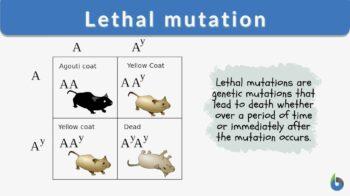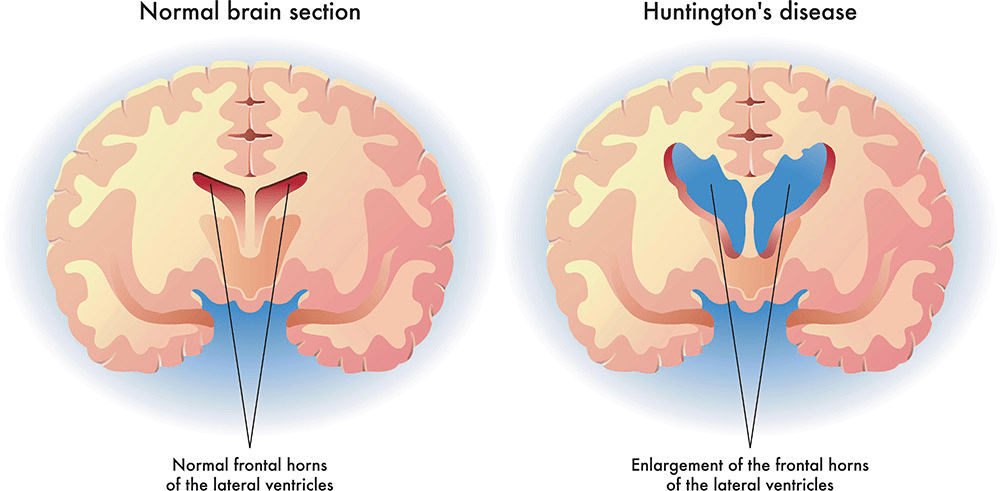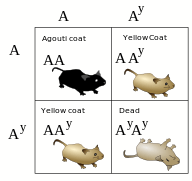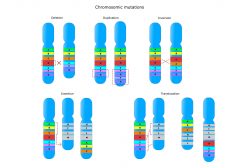
Lethal mutation
n., plural: lethal mutations
[ˈliːθəl mjuˈteɪʃən]
Definition: a type of mutation that can cause death
Table of Contents
Lethal Mutation Definition
Genetic mutations come from changes in the DNA structure or sequencing in an organism. Often mutations can result in many effects made to the organisms and examples of gene mutations can range from no impact to negative effects and some can even be lethal. What makes a mutation lethal? What is a lethal mutation?
To define lethal mutation, one must first think of the meaning of lethal. Lethal means that something has an intense enough impact to cause the death of an organism. So a lethal mutation is a kind of mutation in which the effect(s) might cause mortality or greatly lower the predicted lifespan of an organism bearing the mutation.
Are all mutations lethal? No, as mentioned previously, some mutations may have little to no effect on the organism it impacts. Others mutations may cause disabilities to the organism, whether physically or mentally. This is known as a non-lethal mutation. However, some mutations are quite lethal.
Lethal mutations usually stem from lethal genes or alleles. Depending on the genes involved, fatal genes can be dominant, recessive, or even conditional. The death of an entity can occur at any moment, with the most prevalent occurrence being during the early phases of development. Dominant lethality, of course, stems from a lethally dominant gene or allele. These are the alleles that must be present in one copy in an entity for them to be deadly.
These are uncommon since they induce the death of an entity before being passed on to its descendants. Huntington’s disease is a nice example of a dominant deadly allele observed in humans. It is a neurological condition that eventually leads to death. Epiloia genes are another example in humans. Figure 1 above shows the result of Huntington’s disease on the human brain.

Recessive lethal genes can code for either dominant or recessive features, but they do not induce death unless two copies of the deadly allele are present in an organism. Cystic fibrosis, sickle cell anemia, and achondroplasia are examples of human illnesses caused by recessive lethal genes. Achondroplasia is a dwarfism-causing autosomal dominant bone condition. While one achondroplasia allele can produce the illness, two recessive lethal alleles are deadly.
Sometimes, lethal mutations can be used to benefit the scientific world. Lethal mutagenesis is characterized by an increase in mutation rate to the point that a population is overwhelmed by detrimental mutations and is unable to sustain itself. This strategy has been proposed as the foundation for effective viral infection therapies involving the use of medications known to increase mutation rates.
A lethal mutation is a type of mutation in which the effect(s) can result in death or reduce significantly the expected longevity of an organism carrying the mutation. For instance, brachydactyly is fatal when the genetic defect is expressed during infancy in homozygous recessive individuals. Lethal mutations lead to death whether over a period of time or immediately after the mutation occurs.
Lethal Mutation Examples
There are two main kinds of lethal mutations — conditional lethal mutation and embryonic lethal mutation. Conditionally lethal mutants (different from conditional mutant, which is not lethal) are a subgroup of lethal mutants in which the mutant gene product’s correct function is dependent on environmental variables that may be manipulated in the laboratory. In actuality, the great majority of mutations with a conditionally fatal phenotype are recessive, with the gene product losing function under the nonpermissive state.
Conditional lethal genes can also be expressed in response to environmental cues like temperature. A mutant protein, for example, may be genetically modified to be fully functional at 30°C but utterly inert at 37°C. Meanwhile, the wild-type protein functions normally at both temperatures. Nonpermissive is the state in which the mutant phenotype is manifested. Meanwhile, the state in which the wild-type phenotype is expressed is referred to as permissive.
To examine a conditional lethal mutant, the organism must be kept under permissive circumstances and then switched to the nonpermissive state during a specific experiment. Scientists can investigate and preserve creatures containing dominant lethal alleles by generating a conditional lethal variant of a dominant lethal gene.
Early embryonic lethality occurs before and up to mid-gestation of an organism. It is simple to understand since the stage at which death occurs indicates why an embryo failed. Embryonic lethality is a frequent condition observed in mice with genetically induced mutations. These traits illustrate when and where a gene is required for the first time during development. However, even this has become beneficial to scientific research.
The genetic regulation of key biological processes such as cell division, cell death, cell destiny, differentiation, and morphogenesis has been greatly improved as a result of early embryonic lethality caused by genetically created mutations. As a result, the finding of an early embryonic lethal phenotype represents an intriguing possibility for unique insights into the genetic regulation of biological processes, with substantial implications for biomedical research. Figure 2 below shows the result of a lethal mutation in mice.

Lethal mutations in humans
Humans have one to two mutations on average, which, if inherited from both parents, can cause serious genetic illnesses or death before reaching reproductive age. A vast number of genetic illnesses are caused by recessive mutations, which are safe when only one copy of a gene is present but can cause severe or fatal abnormalities if both copies are present.
Recessive disease mutations are far more common than mutations that cause illness when only one copy of a gene is present, although the pace at which they develop in the general population is unknown. The researchers used a rich family tree and extensive illness data to mimic the transmission of recessive deadly mutations from generation to generation and determine the overall number carried by the original founders.
This enabled them to compute the average number of recessive mutations for each individual. Researchers have discovered around three deadly recessive mutations in every five original founders, however, this only accounted for mutations that enabled children carrying two copies to survive at least until birth.
The scientists determined that each founder had one to two recessive mutations that induce sterility or death before adolescence based on estimates of the fraction of recessive variants that cause mortality during fetal development.
Try to answer the quiz below to check what you have learned so far about lethal mutations.
References
- Bull, J. J., Sanjuán, R., & Wilke, C. O. (2007). Theory of Lethal Mutagenesis for Viruses. Journal of Virology, 81(6), 2930–2939. https://doi.org/10.1128/JVI.01624-06
- Genes and Mutations—Types of Mutations. (n.d.). Retrieved March 22, 2022, from https://www.ndsu.edu/pubweb/~mcclean/plsc431/mutation/mutation4.htm
- Humans carry one to two lethal recessive mutations on average study estimates. (n.d.). Retrieved March 22, 2022, from https://www.uchicagomedicine.org/forefront/news/humans-carry-one-to-two-lethal-recessive-mutations-on-average-study-estimates
- Lethal Genes | Learn Science at Scitable. (n.d.). Retrieved March 22, 2022, from https://www.nature.com/scitable/topicpage/mendelian-ratios-and-lethal-genes-557/
- Papaioannou, V. E., & Behringer, R. R. (2012). Early embryonic lethality in genetically engineered mice: Diagnosis and phenotypic analysis. Veterinary Pathology, 49(1), 64–70. https://doi.org/10.1177/0300985810395725
©BiologyOnline.com. Content provided and moderated by Biology Online Editors.



